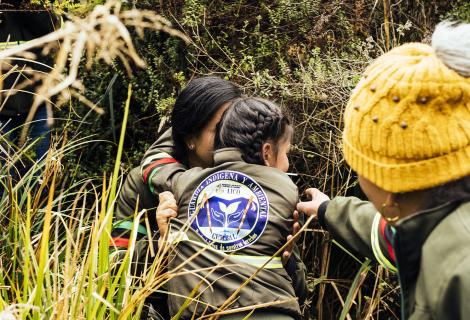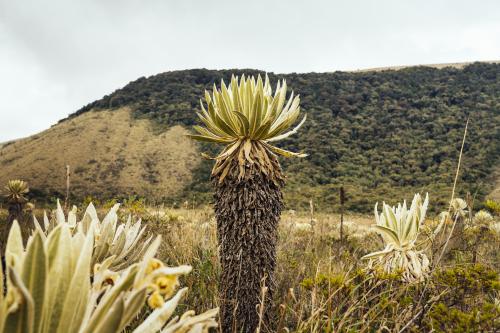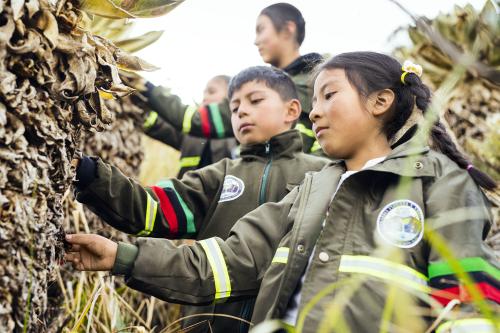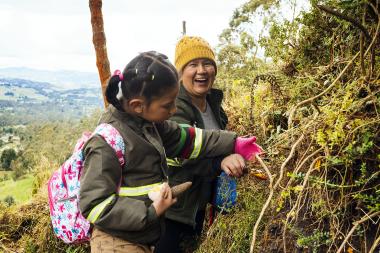An interview with Liliana Merizalde Gonzalez: working with the Environmental Indigenous Guard

Launching on Nature, Land Use, and Oceans Day at COP28, ActionAid is delighted to share a collection of images and videos shot by the Colombian photographer Liliana Merizalde Gonzalez as well as an interview with Liliana.
Liliana spent two days with the three generations of women who are all members of the Environmental Indigenous Guard in the Gran Cumbal region of Colombia: Marisol Cuatín, her daughter Maria José Valenzuela Cuatín, and her mother Luz Marina Cuatín
Liliana went to the paramo with them to see what a typical day looks like.

The paramo is one of the world's most important eco-systems, nestled in mountains between the treeline and glaciers, and one of the fastest evolving eco-systems on Earth. Colombia is one of only three countries in the world that is home to a paramo.
ActionAid and its allied organization in Colombia, Alianza por la Solidaridad, support these women as indigenous guard.
The Nature, Land and Oceans Day serves as a reminder of how we can protect our planet through supporting organisations like the Indigenous Guard. Through stories like these, we can show the impact of the climate crisis and amplify those driving the solutions forward, creating vital change at COP28.
What was your favourite /most inspiring moment of this commission?
The entire commission was very inspiring. Meeting and sharing stories with women like Marisol and Luz Marina who are so connected with nature and humanity in such a pure and beautiful way, is very inspiring. But there were two moments in particular that really touched me. The first was as we were coming down from the páramo with Luz Marina, who is one of the most knowledgeable people I have ever met, on plants and their medicinal uses. At every step she takes, she names each plant, each bush, and each fruit and gives you at least three different recipes and medicinal uses. For me, that is one of the most important kinds of knowledge there is. The other moment was also with Luz Marina during the interview, when she became very emotional and expressed how deeply saddened, she was due to all the damage the climate crisis has caused.

How was it meeting the women and being out with them on guard duty?
It was very interesting. What caught my attention the most is that for them there is no difference between being on guard duty or not. They are always on guard duty, because for them it is not a job, it is a way of understanding the world which is based on care and absolute respect for everything that surrounds us.
What challenges did you face during the commission?
One of the biggest challenges we had, which is almost always present in the commissions I usually work on in different parts of the country, is the issue of security. Traveling through Colombia continues to be complicated because of the presence of different armed groups and this always makes me feel exposed. Fortunately, with ActionAid and its allied organization in Colombia: Alianza por la Solidaridad, we had exceptional support and monitoring from the security department, which made me feel particularly calm. And this is related to the second challenge- due to the security risks we had to wrap up before nightfall, so there was little time to carry out the commission. This limited time makes it difficult to gain the community’s trust and build relationships. But fortunately, we were still able to achieve this thanks to all the people participating in the commission.
What is the best thing about being a photographer?
Being able to travel around the country and get to know it in detail. My work has taken me to 30 of the 32 departments (regions) of the country. For me, the most important thing about this is not only knowing the geography, which is absolutely beautiful and magical, but also meeting the beautiful people, the country women, the farmers, the different indigenous communities, their thinking, and their wisdom. Being a photographer for me is building a relationship with each of the people photographed, even if it is short but it is lasting, it stays in my heart. For me, being a photographer means creating a lasting relationship with each of the people I photograph, no matter how short our meeting is.
What challenges do women photographers face?
I could write a book on this! In general, being a woman in any profession or situation has unique challenges. And in photography this is no exception: women are still more exposed to all types of violence, from physical to psychological. The risk is higher when shooting especially documentary photography, which exposes us to uncertain and sometimes dangerous situations. Having to travel to unknown places (often alone), sometimes not knowing whom you are going to be with or travel with, where you are going to stay, or how you’ll get there, increases vulnerability. We still experience sexist and patriarchal attitudes even in photography. It's harder for us to get hired than for men and even when we get the jobs, we end up with less pay than our male counterparts. This means our profession is more precarious. We rarely are asked what can be done to minimize the risks or dangers. I could go on for hours… What a timely question!

After witnessing the women in their roles as the guard, what would be your message to world leaders at COP28?
One of the most important things is to return to a smaller scale, in every sense, including a smaller scale of production and a smaller scale of consumption. The quest to grow indiscriminately is what has made the earth this way - so painful, so damaged, so bad. Consuming locally-made products, and working towards food sovereignty could lead to decisive changes. Before photography, I studied literature, and the most important lesson was that the ‘how’ is more important than the ‘what’. If we link the ‘how’ with others and nature, we will reach lifesaving results. Indigenous and ancestral wisdom has taught us to have deep reflections on our actions. We must listen to not what people like Marisol and Luz Marina say, but also the unspoken - listening to what they do, listening to what they say about their relationship with the territory, listening to their thought structure based on respect and care, and listening to their relationship with the rest of the people.
Do you think photography and stories can bring about change?
Absolutely! I have always believed that the most profound changes go from the micro to the macro. Because in the macro one stays in the maps, in the numbers, in what is seen from a distance, which is very impersonal. While what has the most potential to move and touch the heart is the most intimate, the most human, sometimes the smallest detail which ends up being the strongest, because it is real, it has a name, a face, tears, and laughter. That's why I totally believe in the potential of visual stories and listening to different people living in different situations, in different parts of the world. Only from there with individual experience and with feeling, can one connect and perhaps even project real change, inwardly and outwardly.